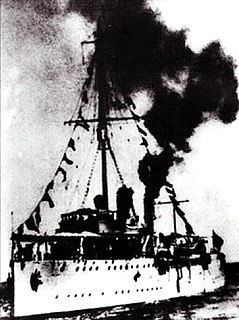
The Battle of the Yalu River was the largest naval engagement of the First Sino-Japanese War, and took place on 17 September 1894, the day after the Japanese victory at the land Battle of Pyongyang. It involved ships from the Imperial Japanese Navy and the Chinese Beiyang Fleet.

A gunboat is a naval watercraft designed for the express purpose of carrying one or more guns to bombard coastal targets, as opposed to those military craft designed for naval warfare, or for ferrying troops or supplies.

The Amur Military Flotilla (AMF) was a military flotilla on the Amur river in the Far East region of Russia.

River monitors are military craft designed to patrol rivers.

The term brown-water navy or riverine navy refers in its broadest sense to any naval force capable of military operations in littoral zone waters. The term originated in the United States Navy during the American Civil War, when it referred to Union forces patrolling the muddy Mississippi River, and has since been used to describe the small gunboats and patrol boats commonly used in rivers, along with the larger "mother ships" that supported them. These mother ships include converted World War II-era Landing Crafts and Tank Landing Ships, among other vessels.

The third USS Lexington was a timberclad gunboat in the United States Navy during the American Civil War.

USS Hartford, a sloop-of-war, steamer, was the first ship of the United States Navy named for Hartford, the capital of Connecticut. Hartford served in several prominent campaigns in the American Civil War as the flagship of David G. Farragut, most notably the Battle of Mobile Bay in 1864. She survived until 1956, when she sank awaiting restoration at Norfolk, Virginia.

The Evacuation of Manchukuo occurred during the Soviet Red Army's invasion of the Japanese puppet state of Manchukuo as part of the wider Manchurian Strategic Offensive Operation of August 1945.
The following is the order of battle of the Riverine Flotilla of the Polish Navy, an integral part of the Polish Navy in the period between the world wars.

The Battle of Pungdo or Feng-tao was the first naval battle of the First Sino-Japanese War. It took place on 25 July 1894 off Asan, Chungcheongnam-do, Korea, between cruisers of the Imperial Japanese Navy and components of the Chinese Beiyang Fleet. Both China and Japan had been intervening in Korea against the Donghak Peasant Revolution. While China tried to maintain her suzerain relationship with Korea, Japan wanted to increase her sphere of influence.

The Soviet–Japanese border conflicts, also known as the Soviet-Japanese Border War,was a series of minor and major conflicts fought between the Soviet Union ,Mongolia and Japan in Northeast Asia from 1932 to 1939. It is the first Soviet-Japanese War.

SS Zhongshan, formerly romanized as Chung Shan, was a Chinese gunboat of 780 tons. Built in Japan in 1913, it was originally known as the SS Yongfeng before being renamed in 1925 in honor of Sun Yat-sen, better known in China as Sun Zhongshan. This ship and others of its class are frequently classified as gunboats.
USS Tulip (1862) was a 183-ton steamer acquired by the Union Navy during the American Civil War.

USS Aroostook was a Unadilla-class gunboat built for the Union Navy during the American Civil War. Aroostook was used by the Navy to patrol navigable waterways of the Confederacy to prevent the South from trading with other countries.
USS Alfred Robb (1860) was a stern wheel steamer captured by the Union Navy during the American Civil War.

USS Samar (PG-41) was a gunboat of the United States Navy. She was initially built for the Spanish Navy, but was captured during the Spanish–American War and taken into service with the US Navy. Samar had two sister-ships which also served in the US Navy, USS Pampanga (PG-39) and USS Paragua.
The Dnieper Flotilla is the name given to the various naval flotillas on the Dnieper River. These were particularly active in four conflicts: the Russo-Turkish wars of 1735–39 and 1787–92, the Russian Civil War, and World War II.
The Wanhsien incident of 1926 was a series of maritime conflicts and civilian casualties on the river Yangtze, between British merchant shipping and regional Chinese military leaders, culminating in a battle with Royal Navy gunboats, which also fired cannons into the city of Wanhsien.

The Battle of Obytichnyi Spit was a naval battle fought in the Sea of Azov during the Russian Civil War.

The Manduvirá River Expeditions were the final operations of the Imperial Brazilian Navy carried out on the Paraguayan War. The goal of the imperial fleet was to carry out explorations along the river and its streams, with the aim of capturing or destroying the remaining ships of the Paraguayan armada that had taken refuge. The Brazilian fleet was composed of eighteen ships, including battleships, monitors, gunboats and steamboats while the Paraguayan fleet had about a dozen steamers. A total of three expeditions were carried out, which proved to be extremely dangerous for Brazilian ships due to the sinuosity of the river and the blockades created by the Paraguayans.














